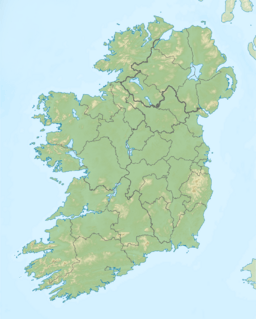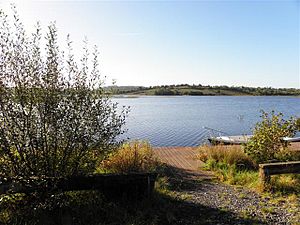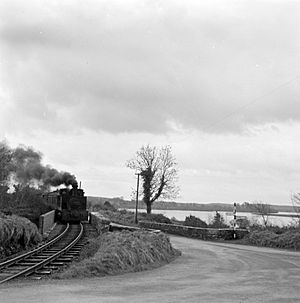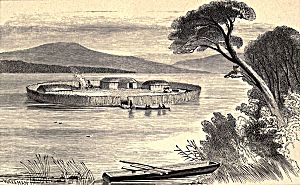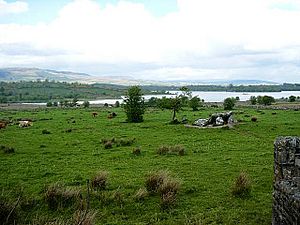Lough Scur facts for kids
Quick facts for kids Lough Scur |
|
|---|---|
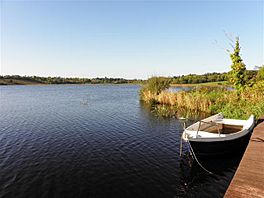
Lough Scur at Corglass
|
|
| Location | County Leitrim |
| Coordinates | 54°1′31″N 7°57′21″W / 54.02528°N 7.95583°W |
| Lake type | Freshwater |
| Native name | Loch an Scoir Error {{native name checker}}: parameter value is malformed (help) |
| Primary inflows | Aghacashlaun River, Shannon–Erne Waterway |
| Primary outflows | Shannon–Erne Waterway |
| Catchment area | 62.87 km2 (24.3 sq mi) |
| Basin countries | Ireland |
| Surface area | 1.14 km2 (0.44 sq mi) |
| Max. depth | 5 m (16 ft) |
| Surface elevation | 62 m (203 ft) |
| Islands | 2 |
Lough Scur is a beautiful freshwater lake located in south County Leitrim, in northwest Ireland. It is an important part of the Shannon–Erne Waterway, a route that connects many lakes and rivers. People have lived around Lough Scur for a very long time, since the New Stone Age.
Today, you can find quays and moorings for boats here. Some important historical spots around the lake are protected. These include Castle John, three ancient lake dwellings called Crannogs, and a special path to Rusheen Island. However, "Jail Island" is not protected. Like many lakes, Lough Scur faces challenges from pollution and plants or animals that don't belong there, like curly waterweed and zebra mussels.
Contents
What Does the Name Lough Scur Mean?
The name "Lough Scur" has an interesting history. Some old stories from the 1800s said it was named after a hero called Oscar. They even thought his grave was nearby.
However, experts believe the word "Scur" (Scor in Irish) has different meanings. It most likely means "lake of the horse-stud" or "lake of the camp." This suggests that horses might have grazed here, or people set up camps by the lake long ago.
Exploring Lough Scur's Geography
Lough Scur is located about 1 kilometer northwest of Keshcarrigan. The lake covers an area of about 1.14 square kilometers. It is generally quite deep, with a soft, muddy, or peaty bottom. The northern part of the lake is shallower. This is probably because a mountain stream brings a lot of dirt and debris into it.
Lough Scur is connected to several other lakes. Lough Marrave is so close and at the same level that it feels like a part of Lough Scur. Keshcarrigan Lough and Carrickaport Lough also flow into Lough Scur through small streams. Drumaleague Lough, to the southwest, is connected by the Shannon–Erne Waterway.
The area around Lough Scur shows signs of the ice age. Huge glaciers moved across the land millions of years ago. They left behind special landforms called Rogen moraines and many small hills called drumlins.
Wildlife and Water Quality in Lough Scur
Lough Scur is home to various fish species. You can find "roach-bream hybrids," which are a mix of two types of fish. There are also roach, perch, bream, and pike. Pike are large fish that eat other fish. The pike in Lough Scur are the "native Irish strain," meaning they are originally from Ireland. Some very large pike, weighing 10 kilograms or more, have been caught here!
In 2002, surveys found no zebra mussels in the lake. These mussels are an invasive species that can harm the lake's ecosystem. In 2005, the water quality was rated as "mesotrophic." This means the water has a moderate amount of nutrients, which is good for a healthy lake.
Human Activity and Lough Scur
The Shannon–Erne Waterway Canal
Lough Scur is an important part of the Shannon–Erne Waterway. It sits at the highest point of the canal that links Lough Scur to the River Shannon. This canal was first built in the 1840s. It was used for transport until trains became popular.
However, the canal was reopened in 1994 to help bring tourists to the area. Waterways Ireland controls the water levels of Lough Scur using two special gates called spillways. Long ago, people used dug-out canoes to travel on these waterways. This shows how important lakes and rivers have always been for getting around in Ireland.
Villages Near Lough Scur
The main villages close to Lough Scur are Keshcarrigan and Drumcong. These are the places where people have settled around the lake.
Lough Scur's Rich History
Stone Age Discoveries
People might have lived near Lough Scur as early as 8,000 to 4,000 BC, during the Mesolithic period. Archaeologists have found several interesting items from this time. These include stone flakes, a polished stone axe, and even a piece of leather found under an old dug-out canoe. The stone flakes are likely from the Mesolithic era.
Experts also believe that small Stone Age lake dwellings, called crannogs, were found at Lough Scur. These were circular stone platforms, about 6-10 meters wide, built above the lake mud. Inside, they had wood and stones. Charred animal bones found there show that people ate wild boar and oxen.
Bronze Age Life at Lough Scur
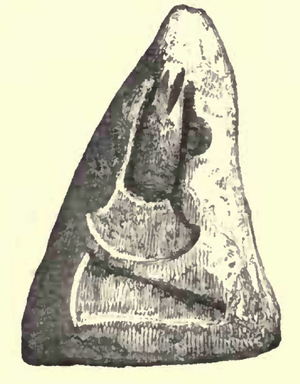
A Bronze Age settlement existed at Lough Scur around 4,000 to 2,500 BC. A special item called the "Lough-Scur Stone Mould" was found on a crannog here. This triangular stone block has shapes carved into it. These shapes were used to cast tools like flat axes or spearheads from copper and bronze. This happened before people learned to use iron. The mould shows how people made tools long ago.
Iron Age Finds and Crannogs
Lough Scur has five or six crannogs, which are artificial islands where people lived. Many ancient items from the Iron Age have been found here. These are now kept in museums like the Royal Irish Academy and the National Museum of Ireland – Archaeology.
Some of these finds include:
- Stone flakes, a shale axe, and a piece of leather.
- The "Lough-Scur Stone Mould" (mentioned above).
- The "Lough-Scur Quern-stone", a large stone used for grinding grain.
- The Kiltubrid Shield, found nearby.
- The Keshcarrigan Bowl, found in the canal.
- Many animal bones, suggesting what people ate.
Aghascur Druid's Altar
South of the lake, there's an ancient stone monument called "Aghascur." It's often called "Dermot and Grania's Bed" on maps. This monument might have been a special place for Druids before Christianity arrived in Ireland. It's a very old and mysterious site.
Castle O'Connor: A Medieval Fortress
In 1265 AD, a leader named Aedh mac Felim Ó Conchobair built a fortified "castle" at Lough Scur. This castle helped protect the local people, called the Conmaicne, from invaders. The forces from Lough Scur even took part in an important battle in 1270 AD, the Battle of Áth an Chip.
The Castle of Lough Scur
Crannogs continued to be used as fortified homes during the Middle Ages. Old Irish records mention a strong crannog at Lough Scur. For example, in 1346, some people were captured on Loch-in-sguir and later killed. In 1390, a man named Manus O'Rourke escaped from one castle and went to the castle of Lough-an Scuir, but he was sadly killed there.
In the 1800s, parts of a heavy oak frame with special cuts were found on a crannog here. This shows how these lake dwellings were built.
Castle Sean and Its Story
Around 1570, a man named Sean Reynolds built a castle called 'Castle Sean' on a peninsula. This castle was three stories tall. Sean Reynolds and his family lived there for many years. The castle was probably abandoned around 1729.
Today, you can still see the ruins of Castle Sean (Caisleán Seóin in Irish). It's not officially protected, but some parts were repaired around 1908 by a group that wanted to save historical sites.
Prison Island
In 1605, Sean Reynolds and his son Humphrey were put in charge of the jail for county Leitrim. They built a 'prison' on 'Jail Island' (Oileán an phriosuiin) in Lough Scur. The jail cells were very small. Stories say many people were held captive on the island. This prison was later abandoned when a new jail was built in Carrick-on-Shannon. The ruins of the prison are still there, but they are not protected.
Metalworking History
Lough Scur has a history of metalworking. Records from the late 1500s show that five metalworkers from "Lougheskure" received special pardons. These metalworkers included Gilla Gruma O'Flynn, Charles O'Flynn, Toole O'Fenane, Teige oge O'Fonan, and Eoin O'Finan. Some were even called "Tinker metal workers."
The Mysterious Book of Lough Scur
In the early 1900s, there were rumors about a book or manuscript called the "Book of Lough Scur." This book was supposedly about the Reynolds family. It was thought to be in the library of someone who had passed away near Keshcarrigan. People were very interested in finding this book to learn more about the Reynolds family history. However, it's not clear if the book was ever found.


